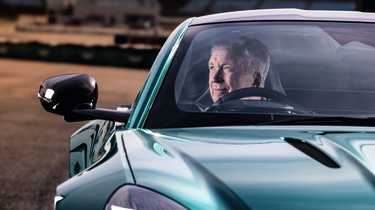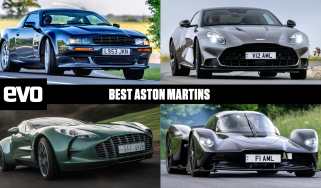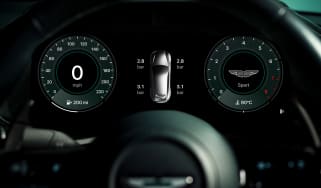Inside Aston Martin’s bold comeback plan – from CEO, Adrian Hallmark
With a raft of new models on the way and a ‘boring’ but vital plan to sort logistics and manufacturing, Aston Martin CEO Adrian Hallmark goes for a drive with evo
You have to brake a little earlier for this first bend. Use a dab of the brakes to get the weight transfer over the nose before you turn in. Then flow it through before this quick direction change, hard on the brakes for the hairpin and keep it nice and clean on the exit to maximise your speed along the straight.’ The running commentary inside the Vantage as it howls around Aston Martin’s Silverstone test track is coming not from former factory driver Darren Turner, nor current hotshot Harry Tincknell. And Fernando and Lance are still on the other side of the world. No, it’s coming from Adrian Hallmark, sometime Radical racer, soon-to-be pilot, qualified engineer and the man Lawrence Stroll has appointed as his fourth CEO to finally get AML moving in the direction the Canadian billionaire feels will repay the millions he’s invested.
Adrian Hallmark is an evo kind of CEO. When working for Porsche in the 1990s he handed back his Audi S4 company car and bought himself a 911; he’s had a succession of 911s since and still owns one today (his current company cars are a DBX and Vantage). During his time at Jaguar Land Rover he presided over the launches of F‑type and F‑Pace before heading to Bentley to lay down a strategy that would see the company become a leader in sustainable luxury as well as manufacturing luxury cars on a scale few, if any, can match.
> Aston Martin Vantage Roadster 2025 review – the Ferrari Roma Spider's toughest rival
At Aston Martin, the challenges he faces are in plain sight. The company’s financial performance is scrutinised to a degree otherwise unseen in the sector, partly because of all the noise when the company went public, partly because of Stroll’s ambition to create a British Ferrari, and mostly because AML has jumped from one financial pothole into another. But many crucial pieces were put in place by Hallmark’s predecessors and now he has to bring them all together and make the whole work. So we asked him how he plans to do it.
And to kick off, has what he’s found on the inside at Aston Martin matched the perception he had from the outside? ‘I’ll start with the good stuff,’ he replies. ‘I did not imagine how much more emotionally charged and how much more love there was for this brand than Bentley. I was at Bentley almost seven years and I can’t remember anybody walking over and saying “I like your car” or being photographed in one. Now I can’t go anywhere without somebody talking to me about the car I’m in.’ Indeed, as we drive to Silverstone we’re held up at a mini-roundabout while a kid pleads with his mum not to move until he’s captured the Vantage to his phone’s memory.
The public is one demographic, but dealers and staff can be tougher audiences to crack and neither group has had it easy of late, despite the product line-up arguably being the best it has ever been.
‘I didn’t think it would be as positive,’ says Hallmark. ‘When you talk to the dealers, because you can see from the outside what they have been through, I thought this is going to be an absolute whinge-fest. The good news was that I know probably half of them from my time at Porsche, JLR or Bentley. They have all been hugely constructive, hugely supportive and they all believe that this is it. We’ve cracked it. The product range, everything… it’s never been better.’
In 2020 the DBX gave a taste of what Aston Martin could deliver when provided with the resources to do so, but there was no solid product follow-up. It wasn’t until 2023 and the arrival of the DB12 that we got to experience the first Stroll-era Aston and a sense of what his plan looked and drove like. DB12 proved a big step in the right direction, new Vantage a real leap forward over the model it replaced. And then came Vanquish, the best car the company has ever produced. ‘And winning road tests against Ferrari on a regular basis. I don’t think we’ve ever done that before. And four new cars [including the new DBX S] in 18 months; I don’t know any company of this size achieving this to this high a standard.’
Getting people into the brand isn’t the challenge some would suggest it is. ‘We’re 63 per cent conquest [sales] currently, and nearly all Valkyrie customers were new to the brand and had never owned an Aston Martin before. Valhalla is 50 per cent [conquest].’ The challenge is keeping them within the Aston family to become repeat customers, and Hallmark says that despite its competitiveness, the current line-up is too ‘thin’. If you own a current model and wish to change it after a couple of years, where do you go? From Vantage straight to DB12 doesn’t feel like a natural step.
Which is where a new Hallmark strategy comes in this summer. It starts with expanding the current product line-up ‘not in a Porsche 911 way; we won’t have 24 derivatives of a Vantage’ but including an ‘S’ variant of each model, starting with the DBX S – more power, lightweight options and a mild design tweak front and rear. ‘When we sold the DBX as the world’s fastest SUV we alienated nearly 80 per cent of the market by only offering an ultra-high-performance model.
‘So, at the risk of contradicting myself, the new S will be a more extreme 707, with an even more extreme version in the pipeline, but we’ll also go the other way and wind it back to give us four DBX models to appeal to a wider customer base. A Lamborghini Urus and a Bentley Bentayga share the same platform and hard-point components; the DBX is our own platform, and we can – and should – be doing more with it.

‘For five per cent of the bill of materials, we can create Jekyll and Hyde DBX products that appeal to multiple customer demographics, where previously we only had one.’ Although don’t expect to tow with your new DBX; Hallmark wants to ban towbars. But do expect even more choice when it comes to personalisation.
The same approach will be taken with the front-engined coupes, with three derivatives of each model and a focus on extracting more performance and personality from them all. And Vanquish and Valhalla will donate their platforms to create the next family of ‘specials’, some of which will include a new, more cost-efficient manual gearbox that will make its way into other models, too. Vantage Touring, anyone?
The product sounds tantalising, the plan achievable, even in a world of such uncontrollables as tariffs. ‘We knew they were coming and prepared the stock flow to the US for April to minimise the impact and buy time with dealers and customers to discuss our options,’ Hallmark says. Elsewhere, supply chain issues still hang over the whole sector, with a number of tier-one suppliers hitting serious financial troubles. ‘There’s one company that makes all the dashboards for everyone and they went to the wall. It’s resolved now, but the disruption impacted every process.’
There are also opportunities. The debt pile is high, but there is cash in the bank to provide the liquidity required: more investment from Stroll, and AML selling its stake in the F1 team, injected nine figures onto the balance sheet in March, and the redistribution of the capital expenditure laid down for the paused battery electric vehicle programme has been diverted to these more immediate projects. Hallmark also brings with him relationships with suppliers new to Aston Martin that can offer broader and more efficient opportunities. Such as being able to utilise the Valhalla’s hybrid system to provide electric drive to the front axles of the front-engined cars. And getting the V12 through the Euro 7 emissions regulations.
Then there’s what is already at Hallmark’s disposal, including Gaydon and St Athan. The latter is vast, too big really, but it does provide somewhere to create pilot production halls to nail the manufacturing of any new model before introducing it to the lines at Gaydon. It de-risks the production process and improves quality as it allows for any shortcomings to be Aston’s issue at the start of a project rather than the customers’ problem after the cars are delivered.
Unfavourable headlines (170 redundancies this year) and headwinds (profit still seems a long way off) have dogged AML for generations. Hallmark plans to change this with his ‘boring plan’, one that will bring stability and, crucially, the revenue streams to meet the targets demanded by the money markets.
The ‘boring plan’ for logistics and manufacturing might be just that, but the cars themselves sound anything but. If Adrian Hallmark can handle Aston Martin’s boardroom as deftly as he can manage a Vantage around the Stowe circuit, Stroll’s investment should be safe, and the company’s future more secure than it has been at any time in the last decade – or its entire 112 years.
This story was first featured in evo issue 334.








